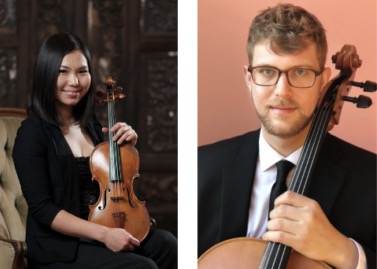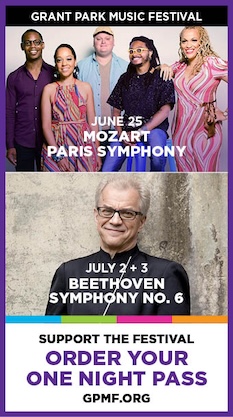Principals take the spotlight in Illinois Philharmonic’s Brahms program

For those who are getting impatient to take off the masks at orchestra concerts, let them come to Palos Heights.
Illinois Philharmonic Orchestra concerts are now a mask-optional experience. About 80% of patrons chose to go sans mask at IPO’s all-Brahms program Saturday night at Trinity Christian College.
As its season winds down, the southwest suburban orchestra is on a roll. In March IPO chief Christina Salerno was named executive director of the year by the Illinois Council of Orchestras (following the IPO being named orchestra of the year in 2020).
Salerno’s award is well deserved. Few large ensembles retooled more quickly for Covid shutdowns and pandemic capacity limitations than the IPO under her leadership. The orchestra presented outdoor chamber concerts—two a day to accommodate more audience members due to widely spaced seating. And while many organizations cancelled entire or massive parts of their seasons, Salerno consistently pushed the envelope for her orchestra’s return—even doing live-streamed string orchestra concerts (with limited in-person capacity) as early as October 2020. She has also diversified the orchestra’s repertoire and far exceeded fund-raising in a drive to guarantee the IPO’s future, doubling the original goal to a total of $4 million.

And now Salerno is once again out front, having the IPO dispense with mandatory mask mandates while other organizations continue to dither.
Meanwhile, the artistic side remains secure under IPO music director Stilian Kirov, as shown in the orchestra’s strong showing in Saturday night’s Brahms lineup.
Kudos to Kirov for programming the least-played of Brahms’ four concertante works, the “Double” Concerto in A minor, and giving two young IPO principals the opportunity to share the spotlight.
Brahms famously wrote this late work as a peace offering to violinist Joseph Joachim. Their long friendship and professional association—Joachim premiered Brahms’ Violin Concerto—had ended when the volatile violinist unfairly accused the composer of taking his wife’s side in the couple’s messy divorce. But the professional overture was accepted, the men were reconciled, and Joachim gave the concerto’s first performance (with his quartet cellist Robert Hausmann) and Brahms conducting.
While the concerto is not programmatic, against this background it’s hard not to feel that the composer is having some droll amusement by depicting Joachim and himself as the dueling solo instruments. Sometimes they play the same line together, throwing melodic fragments back and forth; sometimes they are in rancorous conflict. In the Andante, they initially play the lyrical theme an octave apart; the violin seems to be protesting strenuously and is gruffly and repeatedly cut off by the cello—nearly the sonic embodiment of the famously curt and sarcastic composer.
IPO concertmaster Azusa Tashiro and principal cellist Jacob Hanegan made a pair of contrasted yet complementary solo protagonists, both contributing polished and fiery playing. At times one wanted greater body and projection from Tashiro’s slender tone, but the violinist’s playing was technically immaculate and throughly musical throughout.
Hanegan played like a true soloist with robust tone and hair-trigger rhythmic sensitivity. From his extended solo in the opening bars, he brought personality-plus playing to every opportunity, plumbing a wide array of expression and dynamics.
Despite the divergent musical personalities, the soloists were largely simpatico in this challenging score—stormy and yielding by turn in the opening movement (some outside thunder adding to the drama), ruminative or querulous as required in the Andante and jocular and energetic in the bustling finale.
This score has its potentially turgid moments if momentum flags. Kirov kept the music on the move, ensuring both soloists were always audible and that orchestral tuttis had vigor and punch. Apart from a couple unfortunately timed horn bobbles, the orchestra gave their colleagues fine support.
The IPO possesses a richer string sound than most regional ensembles. On Saturday Kirov placed cellos just right of center facing the audience with violas outside on the right. That arrangement helped produce a strikingly dark and weighty corporate tone, which proved ideal in Brahms’ Symphony No. 2.
Among his many admirable traits as a conductor, Kirov always has the work’s larger architecture in sight and this was manifested once again in this organic and concentrated Brahms Second. The conductor took a daringly spacious tempo for the opening section but sustained it convincingly. The stormy drama and pastoral lyricism of the opening movement registered with clear and natural expression. After more lapses, the horns managed to get it together with an elegant solo near the end of the movement.
The Andante plumbed an idiomatic vein of Brahmsian rumination, Kirov ensuing the build to the emotional climax was pointed effectively. The ensuing third movement was aptly pastoral and vigorous.
Kirov took a more stately tempo than usual for a finale marked “con spirito” and, oddly for this conductor, the movement ignited rather belatedly in the final section. Even if sparking late, the players gave Brahms’ fail-safe coda its full brassy and exhilarating finish.
At times one wanted more nuanced dynamics in the brass and winds, most of whom seemed set on forte and above all night. Still, this was a committed and enjoyable Brahms Second, which benefited from the weighty burnish of the IPO strings.
The program began with vital performances of two Hungarian Dances (Nos. 5 and 6) in the Parlow arrangements, Kirov nicely pointing the tempo contrasts.
The Bulgarian conductor began the evening by noting that he prefers to let music speak for itself and rarely makes introductory comments. But he said the fact that Russia’s invasion of Ukraine was still continuing made it necessary for him to voice support for the embattled “freedom fighters.” That support was made musically manifest with the ensuing sonorous performance of the Ukraine national anthem, the IPO audience standing in respect and support for the beleaguered nation.
The Illinois Philharmonic Orchestra concludes its season May 14 with Martha Horst’s Reverberations, Rimsky-Korsakov’s Scheherazade, and Prokofiev’s Piano Concerto No. 3 with soloist Alexander Toradze. ipomusic.org
Posted in Uncategorized

